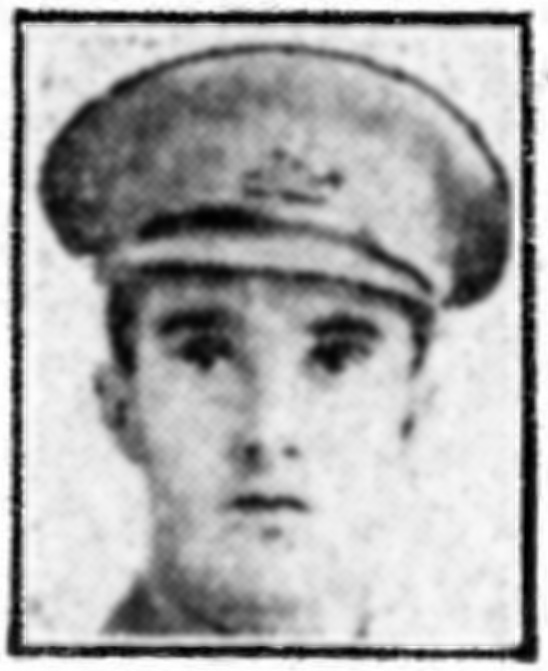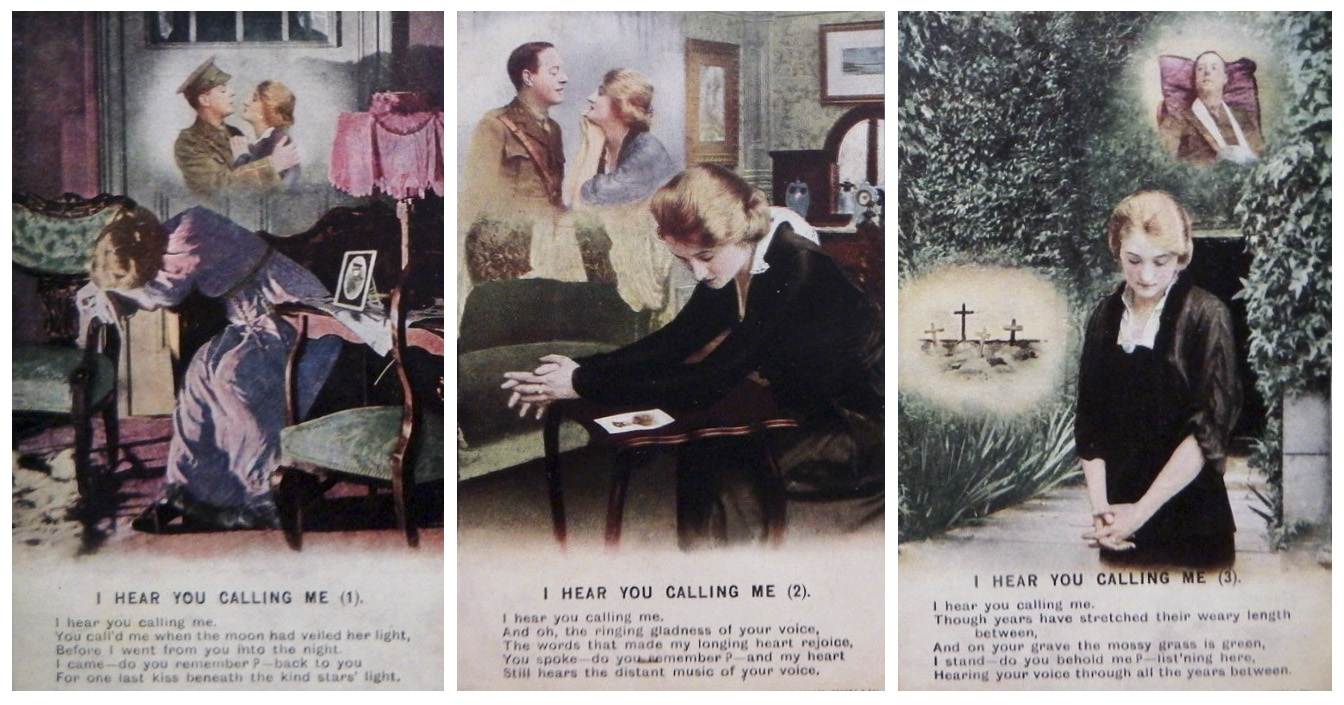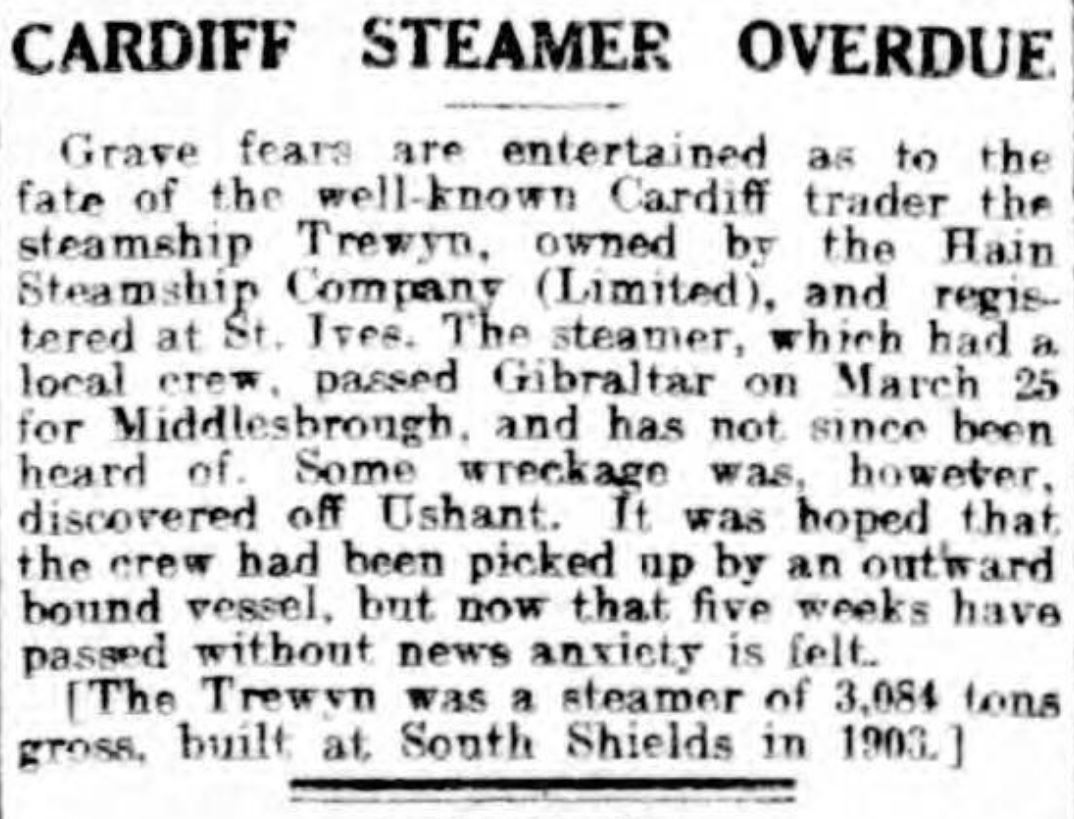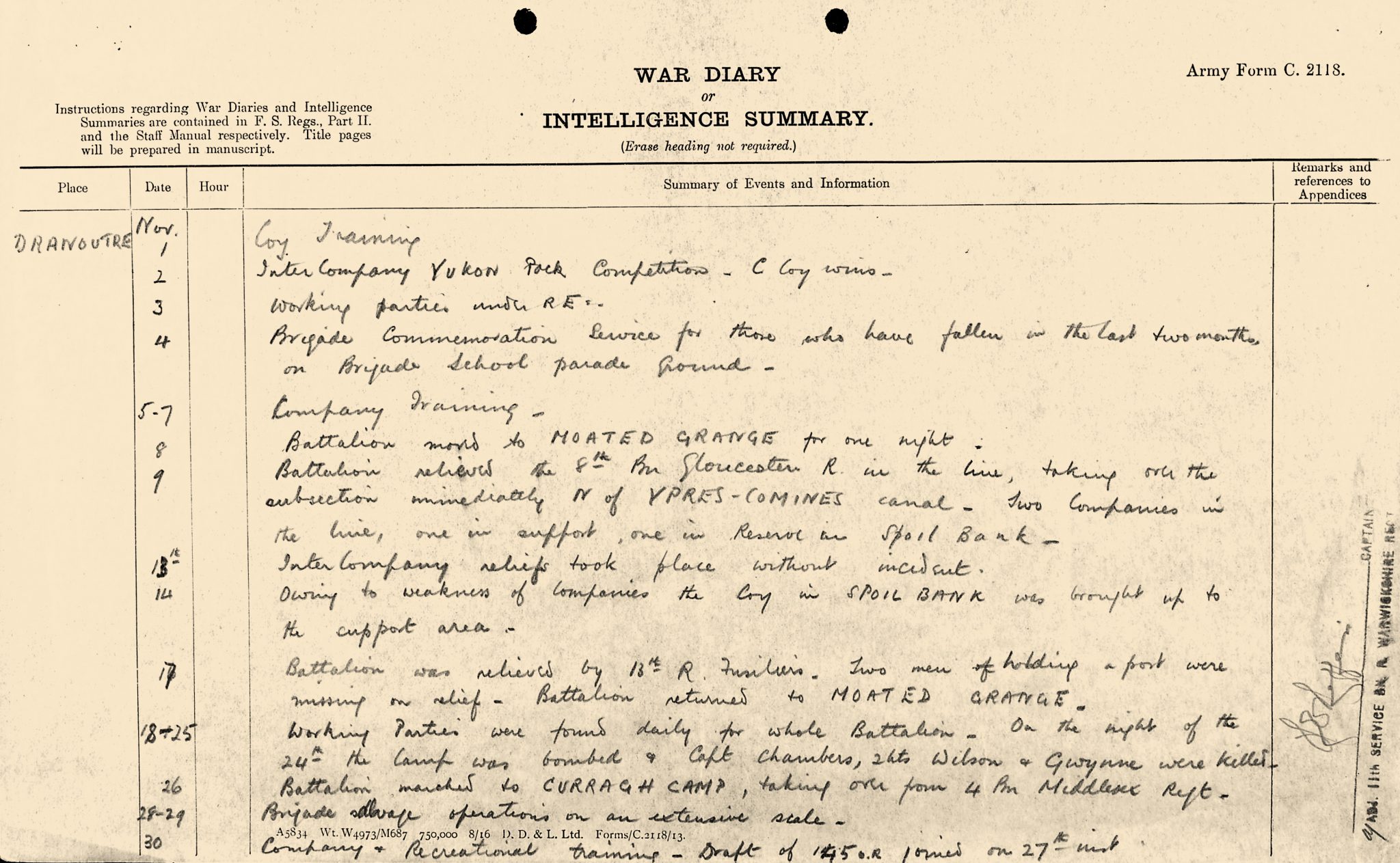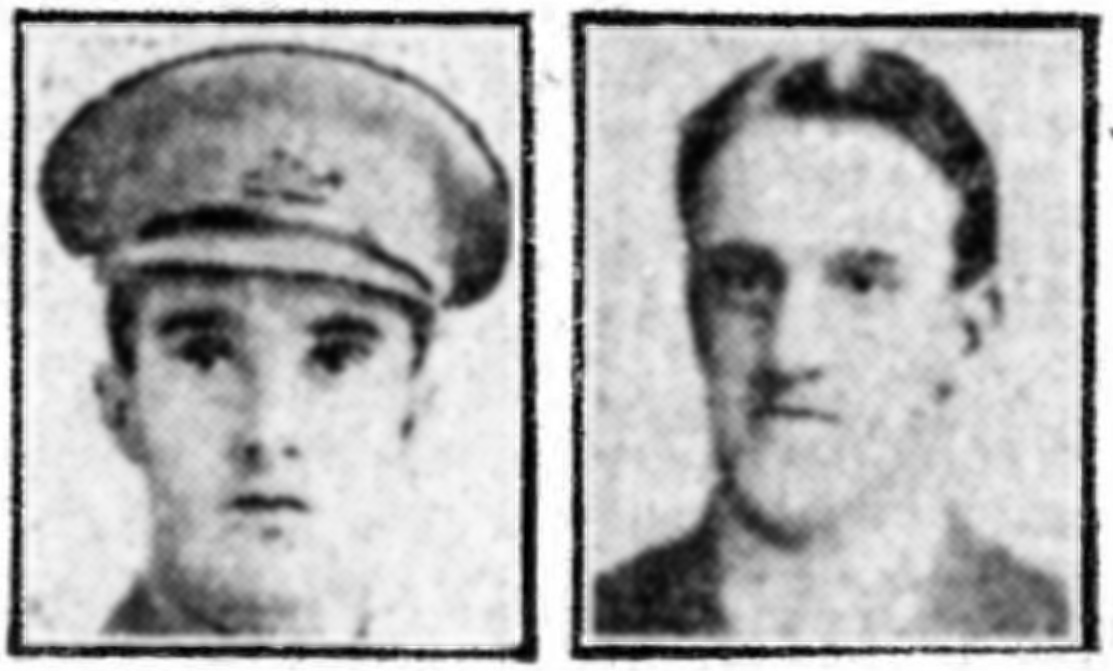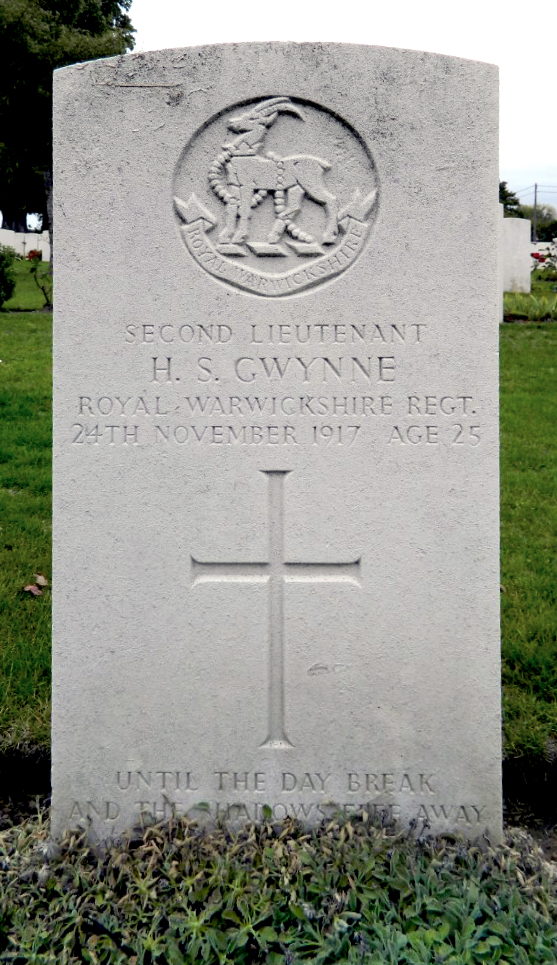Henry Stanley Gwynne
2nd July 1892 – 24th November 1917
Second Lieutenant Henry Stanley Gwynne, of the 6th Battalion Royal Warwickshire Regiment, was killed in action on the Western Front on 24th November 1917.
Home Life
Henry’s parents were both from southwest Wales: his father Henry Thomas was born in 1855 in Rosemarket, near Haverfordwest in Pembrokeshire, and his mother Jane (née Davies) came from Carmarthen,1
born 1854. Jane spoke both Welsh and English but Henry Thomas only English.2 They married in 1880 and settled for a short time in Cardiff.
Henry Thomas’s employment history is a good example of starting at the bottom and working your way up. It was also many a schoolboy’s dream. He was employed by the Great Western Railway Company where he had begunwork as an Engine Cleaner at the Goods Depot, Carmarthen on 5th January, 1871, just turned 15 years of age. He worked his way up through the GWR ranks, rising from Goods Fireman to 1st Class Fireman (1881), Engine Turner (1885), 3rd Class Engineman (1889), 2nd Class Engineman (1895) and finally, on 12th July 1900, 1st Class Engineman—the passport to driving express passenger trains.3
His GWR work made for a peripatetic existence. Although we do not have firm dates, we can trace the family’s peregrinations from employment, census and birth records. His duties took them from Cardiff (early 1880s) to Slough (mid-1880s), back to Cardiff (mid-1880s to late-1880s) then Bedminster, Bristol (turn of the century) and finally back to Canton, Cardiff, shortly after 1901.
Children were born to the newly-wedded couple: Margaret Mary in 1881 (Cardiff), Edith in 1885 (Slough), Alfred John in 1887 (Cardiff), Beatrice in 1889 (Cardiff) who died around her fifth brithday, and Henry Stanley in 1892 (Cardiff). The family’s census return in 1911 tells us that there was another child, deceased, but we do not know either the name or date of birth. Possibly she was in the five-year gap between Margaret and Edith and, if so, she must have died before the age of 9.
Margaret and Edith are both listed in 1901 having ‘Photography Apprentice’ as their occupation. Alfred had left school at the age of 14 and was a Post Office Telegraph Messenger. None of these early career choices became permanent: in 1911 we see that Margaret stayed at home (no occupation stated), Edith became a school teacher in Cardiff, Alfred completed an engineering apprenticeship as a marine engineer in Bristol, and Henry Stanley followed older sister Edith into the classroom.
Henry’s schooling would have been somewhat disrupted by the family moves. According to his later Student Record, Henry had attended Cardiff Council School. This must have been the very tail end of his primary education, after returning from Bristol. The exact school name is not specified. The nearest Council School was Wood Street School, near Cardiff Arms Park, one mile away from the family home; they lived in a bay-windowed terraced house in Landsdowne Road, overlooking the GWR main line. He then moved up to ‘Cardiff Intermediary [sic] School’. The latter was the forerunner to City of Cardiff High School for Boys, and was in Newport Road, Cardiff, four miles from home.
Henry’s education and entry into the teaching profession then becomes a puzzle. The usual path would have been to sit an entrance exam for training college (the ‘Preliminary Examination for the Certificate’), leave the secondary education at 18, and spend one year (maximum) as an unqualified assistant teacher, before proceeding to training college. It would appear that Henry did follow this pattern, but the chronology of his progress is unusual. We know that he passed his entrance exam in 1912 (exact date unknown), at the age of 19 or 20 rather than the expected 17 or 18. In the Census of April 1911 he is still listed as a Student4 at the age of 18—one year older than would be expected. Perhaps illness had intervened to prolong his education; we do not know.
Having decided to teach, Henry needed to undergo formal training in order to be a Certificated Teacher, and for this he chose to apply for a place in Winchester. There is a further missing year before he begins his course in 1913.
Student Life
Winchester Training College, 1913-1915
Henry seems to have started college with gusto as we read in The Wintonian of October 1913, under the title Football Notes, ‘In a 2nd XI match against Whitchurch, Henry Gwynne scored three goals.’ Later is added ‘Gwynne represented the Juniors in the Seniors v Juniors match.’ 5
In March 1914 we read, ‘In the Concert that followed the Past v Present Football Match, Henry sang I hear you calling me.’ This was a sentimental love song on the theme of lovers parting which became very popular and heartfelt during the fast-approaching War.
‘I hear you Calling Me’ appeared on a set of WWI postcards, popular for carrying brief messages between home and front line
As Henry sang, maybe he was thinking of his sweetheart, Eileen Norah Mulligan. We do not know when they met but Eileen was born in Cardiff 1894, the tenth of twelve children. The family lived 300 yards from the Gwynnes, in a central residential area known as Canton.
The college year ended on Friday, 31st July, 1914, 3 days before the Declaration of War. It is as well Henry had thrown himself into his first college year, as a second year of study was not to be.
At War
On September 16th 1913, in his first days as a student at Winchester Training College, Henry enlisted in the College B’ Company of the Royal Hampshire Regiment Territorial Force.6 His Attestation Medical Report tells us that he was 5ft 7¾in tall, had good vision, fairly good physical development and a chest measurement of 35¾in.
When War was declared, the Hampshire Regiment Territorials were already in Khaki:
At the outbreak of war in August 1914, ‘B’ Company was enjoying its annual camp at Bulford on Salisbury Plain. The Company comprised 104 men, 40 of them second-year students. As members of the Territorial Force they were all immediately mobilised and remained under canvas at Bulford for several weeks. They were joined by Principal Wainwright, who held the rank of Captain, and by Bernard Goddard, one of the tutors, who was a Lieutenant in the Company. Early in September the Company returned to Winchester and were billeted in the college buildings, the War Office paying the college 3d. a night for each man and supplying each with rations. The Company remained in college for most of the winter, and in December were sent overseas to India.7
While many of his College friends would leave for India, Henry remained on home soil. It is possible that he had been transferred from the 4th Battalion to the newly-formed 2/6th Battalion—known as the Duke of Connaught’s. This unit was on home service and on 13th February 1915 became a Provisional Battalion and, just to make things more complicated, was also known as Hampshire Brigade Battalion, the 84th Provisional Battalion and, later, the 17th Battalion.
On an Army form dated 14th February 1916, we find that Henry is stationed at Blyth, Northumberland, with the 84th Reserve Battalion. The form is a request for a transfer to the Dorset Royal Garrison Artillery in Weymouth. There is no evidence to say that the transfer was completed, but on 16th May 1916 we find that he was transferred to the 2/8th Battalion Royal Warwickshire Regiment.
We break away from Henry’s service history at this point because, during his time on home soil, the family received worrying news of his brother, Alfred, who had joined the merchant marine. His ship, the SS Trewyn, had set sail from Algiers on March 22nd, 1916, bound for Middlesbrough with a cargo of iron ore. Last seen passing Gibraltar on March 25th, she was reported overdue in early April and listed by Lloyds as officially missing on May 10th. A lifebelt marked ‘Trewyn—St Ives’ had been found off Ushant, Brittany, and the conclusion was drawn that she had been lost with all hands.8
Shortly after his arrival at his new unit, at 7pm on Monday 22nd May, 1916, Henry’s Battalion embarked on two paddle steaners, City of Benares and Princess Clementine, landing at Le Havre at 3am and disembarking at 7am. While all about him must have seemed so unfamiliar, there were at least three friendly and well-known faces 2/8th aboard among the 1021 men—all fellow students. Albert Lewis and Joseph Sharp were in his College year and Merton Rose the year above.
Henry had landed in France and the Western Front beckoned. Following training, the men eventually had their taste of the trenches at Le Quesnoy in Northern France, albeit for training and familiarisation. The Battalion War Diary of 8th June captures the mood:
5pm Receipt of March Orders for occupation of trenches by whole Battalion
7pm Remaining Officers and NCOs of all Companies proceeded to trenches
7.20pm Started to rain heavily
Training continued until 20th June when the men were moved into trenches in the Neuve Chapelle section. While on duty in this area Henry was promoted to Lance Corporal on 18th July. This was a hectic time in the Fauquissart/Fromelles area with major engagements, often called the Battle of Fromelles or the Attack at Fromelles—part of the First Battle of the Somme. The Battalion continued fighting in this sector. On October 31st Henry was again promoted, this time to Corporal, then, on 19th February, 1917, we read in the Diary:
9.20am Battalion moved by march route to Camp 101. Arrived 10.45am. Huts clean but lack of furniture, no latrines or cookhouses, camp dirty. Sergeant Greenaway and Corporal Gwynne to England for commissions.
The following day he arrived back on English soil to attend one of the 21 Officer Cadet Units around the country. The training course lasted four and a half months and each unit had an establishment of 400 cadets at any time. He received his Commission as 2nd Lieutenant on 31st July, 1917.9
Here we come across a gap in the record and therefore in our knowledge of his whereabouts. His papers suggest that he was given his commission in 6th Battalion Warwickshires, yet when he died he was attached to the 11th Battalion. We do not know when the attachment took place or even if he spent any time in the 6th Battalion.
We pick up his story again in mid-October, 1917, by which time he would almost certainly have been with the 11th Battalion Royal Warwickshire Regiment at Ypres, in the middle of the Battle of Passchendaele.
The 11th Battalion was a Service Battalion: providing combat service support to a brigade group and its elements. It also had to be able to fight in a defensive role and provide logistical support to sustain the operations of the other units.
We can follow the details of activities from a biography of 2nd Lieutenant Tristram William Jourdain Wilson (11th Royal Warwickshire Regiment, 1889–1917) who died with Henry.10 The sequence outlined is taken from the Battalion War Diary (NB Not verbatim):
On 16th October the battalion proceeded to a camp N.E. of Ypres on the St Jean – Potise Road and from 18th to 22nd October they worked on the Ypres to Rouliers and Ypres to Zonnebeke Roads, suffering casualties from bombs dropped by day. During this time there was lots of training as well as the Brigade Band competition in which the 11th Royal Warwickshires won the Drum & Fyfe competition.
On the 1st of November the company are training and on 2nd November there was an intercompany ‘YOKON’ competition, won by C Company (but no indication of what this competition might entail)
The 3rd of November was working parties with the Royal Engineers and on the 4th they held a Brigade Commemoration Service for those who had fallen in the preceding two months.
After more company training, on the 8th the Battalion moved to what was known as the ‘MOATED GRANGE’ before moving up to the front line immediately north of the Ypres-Comines canal on the 9th November to relieve the 8th Royal Gloucester Regiment. There then followed a brief description of the way that the 4 companies were rotated, with two companies on the front line, one in support and one reserve in an area called ‘SPOIL BANK’, as was standard practice at this time. On 13th November ‘intercompany relief’, the rotating of the companies, took place without incident but on 14th due to weakness in the companies, the company in reserve in Spoil Bank was brought up to the support area.
On 17th November the battalion was relieved by the 13th Royal Fusiliers. Two men holding a post were reported as missing, but there is no record of other casualties sustained during the 8 days at the front. The battalion returned to Moated Grange where the battalion took part in working parties.
The working parties continued from the 18th to 25th but on the night of the 24th November, we read of Henry’s death, along with two fellow officers. His commanding officer later was to write to his family in Cardiff:
He and two other officers of ours11 were killed by a bomb dropped from a German aeroplane whilst sitting in their company’s mess a few days ago. He was a very capable young officer who was deeply respected by all ranks of his battalion.
The Western Mail carried the following obituary of both Henry and Alfred, on Friday 7th December, 1917 (Portaits below, left to right are Henry and Alfred):
TWO CARDIFF BROTHERS KILLED IN ACTION
Mr. and Mrs. Henry Thomas Gwynne of 31 Lansdowne Road, Canton, Cardiff, have received information that their only two sons have made the supreme sacrifice. They are Second- Lieutenant Henry Stanley Gwynne, Royal Warwickshire Regiment, who was killed in action on the 23rd ult., and Chief Engineer Alfred John Gwynne of the merchant service, who has been posted as missing since the early part of last year and is now presumed by the Admiralty to have been killed. They were aged 25 and 29 respectively.
Lieutenant Gwynne was studying for the scholastic profession at Winchester College [sic] when at the outbreak of war he mobilised with the Hampshire regiment and served 10 months overseas, being promoted to Corporal and recommended for a commission on the field. After receiving his commission he proceeded overseas again about six weeks ago. He was engaged to Miss Eileen N. Mulligan12 of Victoria Park Avenue, Cardiff
Chief Engineer A. J. Gwynne, the other fallen hero, was apprenticed at Peckett’s Engineering Works at St. George’s, Bristol, and went to sea immediately he served his time. He was in the employ of the late Sir Edward Hain.
One year later the family placed a notice of remembrance in The Western Mail:13
In proud and loving memory of Second-Lieutenant Henry Stanley Gwynne, 6th Royal Warwickshire Regiment, dearly beloved younger son of Mr. and Mrs. Henry Thomas Gwynne, 31 Lansdowne Road, Canton, Cardiff, who made the supreme sacrifice for Right and for Humanity in France on November 23rd, 1917, aged 25 years. Sadly missed by his loving Mother Father, Sisters and Fiancée.
Footnotes
[1] Sometimes recorded as St. David’s. This was an area on the western edge of Carmarthen town and should not be confused with the cathedral city in Pembrokeshire.
[2] The Welsh Census of 1891 records Language Spoken’
[3] GWR’s thorough record-keeping system also lists all of his fines for mistakes ranging from the trivial: Engine taken late out of shed through carelessness to the serious: Passing home signal at danger resulting in collision of engine. It also lists his eyesight and colour-vision tests (for correct identification of signalling) and injuries: slipped from footplate and fell onto slope of platform. Back injured.
[4] There is a note alongside the occupation, made in another hand and ink. It is one of the usual post-census notes placing occupations in industrial categories. HS’s note says Engineering. It is likely that this gloss is related to the previous line where his brother Alfred is listed as a Marine Engineer.
[5] Juniors were first-year students, Seniors were second-year.
[6] There is a separate article with more information on the link between the College and the Regiment here <link>
[7] A History of King Alfred’s College, Winchester 1840-1980 by Martial Rose, p.66
[8] No reason for the loss has been found. There was no report from German U-Boats of any sinking in the area near that time. Sea conditions were rough in Biscay at the time. Iron ore is a particularly difficult cargo in rough weather due to hull stresses and cargo liquefaction.
[9] London Gazette, Supplement 30266, 31 August 1917
[10] The full biography on this soldier is at http://www.stmichaels-elmwoodroad.org/heroes-of-chiswick-tristram-william-jordain-wilson/
[11] The other officers were 2nd Lt. TWJ Wilson (see footnote above), and Cpt. SWG Chambers.
[12] Eileen married William H Barry in 1923 and died in Cardiff in 1969
[13] Western Mail, Saturday, November 23rd, 1918
Sources
Ancestry (2018). Home page. [online] Available at: www.ancestry.co.uk [Accessed 2018]
British Newspaper Archive (2018). Western Mail – Friday 07 December 1917. [online] Available at: www.britishnewspaperarchive.co.uk [Accessed 2018]
British Newspaper Archive (2018). Western Mail – Saturday 29 April 1916. [online] Available at: www.britishnewspaperarchive.co.uk [Accessed 2018]
British Newspaper Archive (2018). Western Mail, Saturday, November 23rd, 1918. [online] Available at: www.britishnewspaperarchive.co.uk [Accessed 2018]
British Newspaper Archive (2018). Western Mail – Thursday 11 May 1916. [online] Available at: www.britishnewspaperarchive.co.uk [Accessed 2018]
Commonwealth War Graves Commission, (2018). Home page. [online] Available at www.cwgc.org/ [Accessed 2018]
The London Gazette. (2018). Supplement 30266, 31 August 1917. [online] Available at: www.thegazette.co.uk [Accessed 2018]
St Michael’s Church (2018). HoC – Roll of Honour. [online] Available at: http://www.stmichaels-elmwoodroad.org/heroes-of-chiswick-tristram-william-jordain-wilson/ [Accessed 2018]
Rose, M. (1981). A history of King Alfred’s College, Winchester 1840-1980. London: Phillimore
Vickers, J. The University of Winchester Chapel Memorial Rail image
| University of Winchester Archive “ Hampshire Record Office | ||
| Reference code | Record | |
| 47M91W/ | P2/4 | The Wintonian 1899-1900 |
| 47M91W/ | P2/5 | The Wintonian 1901-1902 |
| 47M91W/ | P2/6 | The Wintonian 1903-1904 |
| 47M91W/ | P2/7 | The Wintonian 1904-1906 |
| 47M91W/ | P2/8 | The Wintonian 1905-1907 |
| 47M91W/ | P2/10 | The Wintonian 1908-1910 |
| 47M91W/ | P2/11 | The Wintonian 1910-1914 |
| 47M91W/ | P2/12 | The Wintonian 1920-1925 |
| 47M91W/ | D1/2 | The Student Register |
| 47M91W/ | S5//5/10 | Photograph of 5 alumni in Mesopotamia |
| 47M91W/ | Q3/6 | A Khaki Diary |
| 47M91W/ | B1/2 | Reports of Training College 1913-1914 |
| 47M91W/ | Q1/5 | Report and Balance Sheets 1904- 1949 |
| 47M91W/ | R2/5 | History of the Volunteers Company 1910 |
| 47M91W/ | L1/2 | College Rules 1920 |
| Hampshire Record Office archive | ||
| 71M88W/6 | List of Prisoners at Kut | |
| 55M81W/PJ1 | Managers’ Minute Book 1876-1903 | |
| All material referenced as 47M91W/ is the copyright of The University of Winchester. Permission to reproduce photographs and other material for this narrative has been agreed by the University and Hampshire Record Office. | ||


